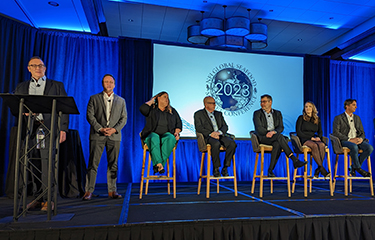The latest projections from market data firm Kontali indicate the global supply of farmed Atlantic salmon will remain relatively flat in 2023, even as demand is projected to increase.
The data, revealed during a panel at the National Fisheries Institute Global Seafood Market Conference – running from January 15 to 19 in La Quinta, California, U.S.A. – indicates farmed Atlantic salmon will see a roughly 1 percent increase in supply. That number, according to Kontali Chief Analyst Ragnar Nystøyl, is assuming no biological issues or unexpected events cause a drop in production.
Broken down by country, some regions will see slight upticks in salmon supply. Norway is expected to increase production by 3 percent, from 1.511 million metric tons (MT) to 1.551 million MT. The U.K. is estimated to see the largest increase in production, rising 8 percent from 170,000 MT to 183,000 MT.
But Chile's production is expected to drop 2 percent from 750,000 MT to 739,000 MT. Canada, meanwhile, is projected to suffer a 5 percent drop from 134,000 MT to 128,000 MT.
Overall, global salmon production is expected to reach 2.906 million MT, a small increase from the 2022 total of 2.866 million MT.
The analysis, Nystøyl said, is based on feed sales for salmonids in 2022. Because feed ratios are relatively stable, Kontali can get an accurate estimate of the amount of biomass in the water.
“The feed gets to the fish, and that tells you how the harvest will be – unless the fish dies,” Nystøyl said.
While theoretically the estimates point to a slight increase in salmon production in 2023, for the most part, the current projections relatively flat production for the second year in a row, Nystøyl said, and don’t take into account the increasingly tumultuous environment for salmon farming in the two largest salmon producing countries in the world – Chile and Norway.
In Chile, BlueGlacier CEO Sebastian Goycoolea said, the regulatory environment has made it very difficult to increase production.
“Today, with the current regulatory system, it is very, very difficult to grow the production in Chile,” Goycoolea said.
He also said mounting pressure from environmental groups and NGOs calling for restrictions on salmon farming in certain regions of the country are having an impact.
“There’s pressure from some NGOs about some farms that are located in protected areas or national parks,” Goycoolea said. “We don’t feel the government has taken, yet, to these demands. But the noise is there and that can represent a significant part of production.”
Coupled with the pressure from NGOs, Covid-19 disrupted the supply chain in Chile as workers were restricted on movement and processing centers faced labor challenges. Those challenges haven’t fully abated, according to Goycoolea.
Norway, too, is facing its own set of political challenges. A new resource tax on salmon farming has caused companies to rethink investments that would have potentially enabled farmers to increase production.
According to Nystøyl, Norway has essentially maxed out the amount of licenses the government will grant for salmon farming, so increasing production will require some creativity. Shifting the production system toward producing larger smolts on land so the amount of time that salmon need to be in net pens is minimized is one way some companies are getting around their inability to gain additional farming space.
However, the resource tax has curbed some of those investments.
“What this taxation does is really to demotivate investment. So it will have an impact in the long run on growth,” Nystøyl said.
On the market side, analysis shows that global demand for farmed Atlantic salmon will continue to increase at a similar rate as in past years. Current Kontali projections indicate that the demand for Atlantic salmon will increase by between 6 and 8 percent.
“Statistics confirm steady demand growth,” Nystøyl said.
Demand, according to the panel, has continued to remain strong even as prices increase. IRI Principal Melissa Rodriguez said salmon has continued to be a major driver of consumption in the retail space.
“Salmon continues to be the powerhouse from a retail perspective, and is driving any sort of growth that we’re seeing in fresh seafood,” she said.
A flat – or potentially decreasing – supply coupled with an increasing demand will inevitably lead to shortages, and long-term supply constraints will only tighten further as a result.
“The main takeaway is there’s no growth. It is yet another challenging year,” Nystøyl said.
Photo by Chris Chase/SeafoodSource







